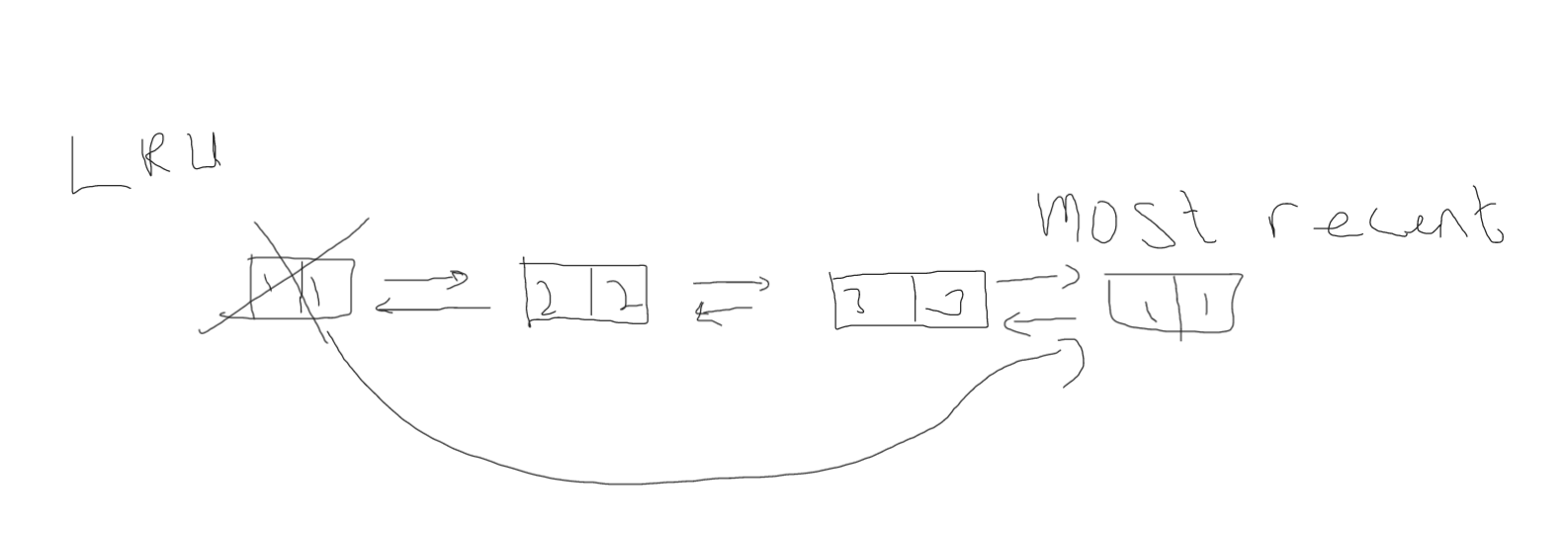
Implementing a Least Recently Used (LRU) Cache in Python
In this post, we will be implementing an LRU cache in Python. We will use a doubly linked list to keep track of the order in which the keys were accessed, and we will use a hash table to provide O(1) access to the key-value pairs.
Designing the LRU Cache Class First, let’s design the LRU cache class. We will name it LRUCache, and it will have the following methods:
- init(self, capacity): Initializes the LRU cache with a positive size capacity.
- get(self, key): Returns the value of the key if it exists in the cache, otherwise returns -1.
- put(self, key, value): Updates the value of the key if it exists in the cache. Otherwise, adds the key-value pair to the cache. If the number of keys exceeds the capacity from this operation, evicts the least recently used key. To implement the LRU cache, we will use a hash table to provide O(1) access to the key-value pairs. We will also use a doubly linked list to keep track of the order in which the keys were accessed. The head of the linked list will represent the least recently used node, and the tail of the linked list will represent the most recently used node.
Here is the code for the Node class that we will use to represent each node in the linked list:
class Node:
def __init__(self, key, val):
self.key = key
self.val = val
self.prev = None
self.next = None
The Node class has four attributes: key, val, prev, and next. The key and val attributes represent the key and value of the key-value pair that the node is associated with. The prev attribute is a pointer to the previous node in the linked list, and the next attribute is a pointer to the next node in the linked list.
Next, let’s implement the LRUCache class:
class LRUCache:
def __init__(self, capacity: int):
self.capacity = capacity
self.cache = {}
self.head = Node(0, 0)
self.tail = Node(0, 0)
self.head.next = self.tail
self.tail.prev = self.head
def get(self, key: int) -> int:
if key not in self.cache:
return -1
node = self.cache[key]
self._remove(node)
self._add(node)
return node.val
def put(self, key: int, value: int) -> None:
if key in self.cache:
node = self.cache[key]
node.val = value
self._remove(node)
self._add(node)
else:
if len(self.cache) == self.capacity:
del self.cache[self.head.next.key]
self._remove(self.head.next)
node = Node(key, value)
self.cache[key] = node
self._add(node)
def _remove(self, node):
prev = node.prev
next = node.next
prev.next = next
next.prev = prev
def _add(self, node):
p = self.tail.prev
p.next = node
node.prev = p
node.next = self.tail
self.tail.prev = node
The _add and _remove functions are private helper methods of the LRUCache class that are used to manipulate the doubly linked list that maintains the order of the keys in the cache.
The _add function adds a given node to the end of the linked list. Here’s how it works:
- Get the previous node (p) of the tail node (self.tail).
- Set the next pointer of the previous node (p.next) to the new node.
- Set the prev pointer of the new node (node.prev) to the previous node (p).
- Set the next pointer of the new node (node.next) to the tail node (self.tail).
- Set the prev pointer of the tail node (self.tail.prev) to the new node.
- Here’s the code for the _add function:
def _add(self, node):
p = self.tail.prev
p.next = node
node.prev = p
node.next = self.tail
self.tail.prev = nodeThe _remove function removes a given node from the linked list. Here’s how it works:
- Get the previous node (p) and the next node (n) of the given node.
- Set the next pointer of the previous node (p.next) to the next node (n).
- Set the prev pointer of the next node (n.prev) to the previous node (p).
- Here’s the code for the _remove function:
def _remove(self, node):
p = node.prev
n = node.next
p.next = n
n.prev = pTogether, the _add and _remove functions allow us to maintain the order of the keys in the cache by efficiently adding and removing nodes from the doubly linked list.
Finally, we’ll implement the LRUCache class that uses the above functions to implement the LRU cache.
class LRUCache:
def __init__(self, capacity: int):
self.capacity = capacity
self.cache = {}
self.head = Node(0, 0)
self.tail = Node(0, 0)
self.head.next = self.tail
self.tail.prev = self.head
def get(self, key: int) -> int:
if key in self.cache:
node = self.cache[key]
self._remove(node)
self._add(node)
return node.value
return -1
def put(self, key: int, value: int) -> None:
if key in self.cache:
node = self.cache[key]
self._remove(node)
node = Node(key, value)
self.cache[key] = node
self._add(node)
if len(self.cache) > self.capacity:
node = self.head.next
self._remove(node)
del self.cache[node.key]
def _add(self, node):
p = self.tail.prev
p.next = node
node.prev = p
node.next = self.tail
self.tail.prev = node
def _remove(self, node):
p = node.prev
n = node.next
p.next = n
n.prev = p
class Node:
def __init__(self, key, value):
self.key = key
self.value = value
self.prev = None
self.next = NoneThe LRUCache class has a constructor that initializes the cache with the given capacity. It also initializes an empty cache dictionary, a size variable that keeps track of the current number of nodes in the list, and dummy head and tail nodes that mark the beginning and end of the list.
The get method retrieves the value of a key from the cache, and returns -1 if the key does not exist. If the key exists, it removes the node from its current position in the list and adds it to the end of the list, marking it as the most recently used node.
The put method sets the value of a key in the cache, and removes the least recently used node if the cache is at capacity. If the key already exists in the cache, it removes the node from its current position in the list, updates its value, and adds it to the end of the